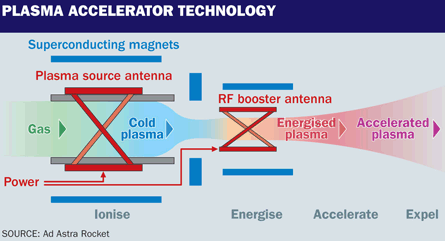President Kennedy laid down a straightforward if daunting challenge: the Moon. President George W Bush, perhaps looking for a Kennedy moment, set that challenge again. From President Barack Obama, a more nuanced directive is no surprise.
But while Obama would forego a headline destination in favour of having NASA develop exotic technologies to enable human exploration of deep space while the private sector takes on the low- Earth orbit transport challenge, one former NASA astronaut thinks he can achieve both goals - and before any crew is carried aloft in a private rocket.
THERE AND BACK
Franklin Chang Diaz believes that his Variable Specific Impulse Magnetoplasma Rocket (VASIMR) technology could be the answer to propulsion problems stretching from the International Space Station to the Moon.
| Chang Diaz's magnetoplasma rocket A Variable Specific Impulse Magnetoplasma Rocket (VASIMR) electric engine uses electricity to accelerate its fuel for thrust. A gas such as argon is injected into a tube surrounded by a magnet and radio wave antennas. Radio waves turn the gas into a plasma, with a net positive charge. Being charged, that plasma can be moved by a magnetic field; in the VASIMR engine it is accelerated by one magnetic field and directed by another - a so-called magnetic nozzle. VASIMR, like other electric propulsion systems, has advantages over chemical engines for in-space propulsion because it is hugely efficient and can provide thrust for a very long time. Efficiency in a rocket engine is expressed as specific impulse: change of momentum (impulse) achieved per unit of propellant, and measured in seconds. While chemical rockets can achieve around 400s, electrics can achieve thousands of seconds. |
Initially developed 10 years ago in Houston at the Johnson Space Center's Advanced Space Propulsion Laboratory, then headed by Chang Diaz, the technology's electric engines promise super-efficient thrust compared with that provided by conventional rockets.
Since leaving NASA to form his own company, Ad Astra Rocket, Chang Diaz has developed the technology to the extent that his VX-200 test engine achieved 200kW power in testing last September.
That power output is enough to generate 1lb of thrust (0.00445kN) and fulfil the critical role of giving the Space Station a periodic altitude boost.
GIVING A BOOST...
At its 400km (250 miles) altitude, the ISS passes through the thermosphere, residual atmosphere that causes drag on the station, and hence causes it to lose altitude; it needs to be pushed back up to its proper orbit every few months. That is a job performed now by NASA's soon-to-be retired Space Shuttle and visiting autonomous cargo ships such as Russia's Progress, the European Space Agency's Automated Transfer Vehicle and Japan's H-II Transfer Vehicle.
Discussions with NASA about testing the technology on the ISS date to 2008. In August of that year Chang Diaz was briefed by the space agency on the transport options to get the engine to the outpost. VX-200 is now undergoing test campaigns for "critical data" to design a VF-200 flight version. Chang Diaz points out that it is already "the most powerful electric engine in operation today" and for reboosting two would be mounted externally on the ISS.
 |
|---|
Chang Diaz will decide in early 2012 whether to use a SpaceX or Orbital Sciences launcher, and in late 2013 or early 2014 a VF-200 should be transported to the space station.
... OR A TUG
Reboosting is just one business model Ad Astra Rocket is pursuing. Chang Diaz says the VX-200 could also power a "robotic freeflyer space tug" that could be deployed in the 2015 timeframe to perform "a number of jobs: satellite repositioning, refurbishing and disposal".
Moving beyond low Earth orbit, NASA is contracting Ad Astra Rocket for a lunar tug concept study, to take cargo from the Earth to the Moon and back, and deliver equipment in preparation for a human landing.
Houston-based MEI Technologies, which has worked with Chang Diaz since his days in the Johnson Space Center laboratories, is to develop the space tug.
MEI chief executive Ed Muniz says: "Some of [our engineers] date back to Apollo Soyuz, helped design the Shuttle and ISS, and they will help Ad Astra to design the vehicle for specific missions."
Source: Flight International






















